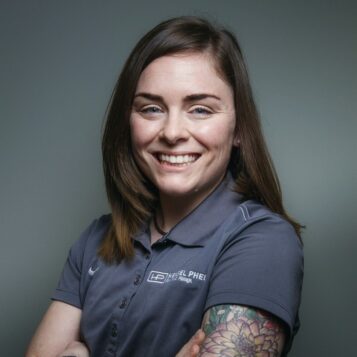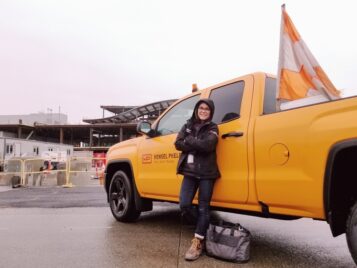Passion, pride + personal empowerment create path for success
By Chris Maday Schmidt
 Kabri Lehrman-Schmid, project superintendent at Hensel Phelps for the past 15 years, brings an engineering and design perspective to her current role, thanks to diverse experience both in the office and the field. In addition, she serves as a role model for females in the industry, as well as an advocate for mental health and suicide awareness and prevention. Join Construction Superintendent as Lehrman-Schmid shares her introduction to careers in construction, to how she eventually came to manage a $450+ million airport modernization project — plus her go-to tips to stay on track and what it took to earn a next-level parenting badge.
Kabri Lehrman-Schmid, project superintendent at Hensel Phelps for the past 15 years, brings an engineering and design perspective to her current role, thanks to diverse experience both in the office and the field. In addition, she serves as a role model for females in the industry, as well as an advocate for mental health and suicide awareness and prevention. Join Construction Superintendent as Lehrman-Schmid shares her introduction to careers in construction, to how she eventually came to manage a $450+ million airport modernization project — plus her go-to tips to stay on track and what it took to earn a next-level parenting badge.
(Q) What drew you to pursue first a career in engineering and eventually move into a project supervisory role?
I knew nothing about careers in the construction industry until I was already an engineering student in NYC. A conversation with a project manager of a large multi-use building project [while serving coffee at my part-time job] led to an internship with the owner’s representative at the Pentagon Renovation. That summer, I excitedly watched the general contractor’s field staff diligently plan and install. The work looked meaningful, logical and I loved how success was directly driven by the contributions of the team. I joined that GC, Hensel Phelps, upon graduation and have spent the last 15 years following their work across the country. I started my career in the field, assisting with formwork, quality assurance, safety management and quantity and land surveying. Though I excelled in both office and field management positions, it was the impact of collaborative relationships in the field that confirmed my passion for the superintendent career path. Now, I enjoy the planning and pressures of building during construction phases of my projects, but also have the skillset (and touch of engineering perspective) to serve as lead design manager in preconstruction phases on Design-Build and integrated delivery projects where stakeholder and design-team collaboration are valued.
(Q) Can you elaborate on how you leverage technology to enhance constructability?
Creating a successful plan is the primary role of a superintendent; however, that plan really means nothing unless it is successfully communicated. The extra effort it takes to find the right technology to provide clearer visualization or message distribution pays off with team buy-in, yes, but the best outcome is if the audience understands the plan well enough to challenge it to become more efficient or effective with their contribution. Some examples: A CPM schedule tied to Revit models through Synchro, can be used to verify steel erection sequencing, but also to communicate aircraft position impacts to the security stakeholders. Sketchup 3D site utilization models tell campus facilities how signage will look to students on rerouted sidewalks and tell contractors where their dry shack will be staged. With Propeller, you can use your drone’s topo scan and photography integration to quantify the site grade changes over time for environmental services, while serving as a baseline model for architect modeling and design reviews.
(Q) Talk a bit about your passion for the next generation of female superintendents and the part you play as a role model.
I had an excellent support system at Hensel Phelps that encouraged me to pursue the superintendent career path. Once I got past my own apprehensions about my ability to excel in the position, I quickly realized I had an obligation to represent the position as attainable to other women and students. I do this, first, by delivering on my obligation to excel at my job — serving my crews, staff and clients. Second, by volunteering my time to speak about opportunities in construction with students, to advocate for pre-apprenticeship programs that serve underrepresented communities and by sharing my expertise and network with multiple professional organizations.
(Q) What do you tell other females considering a job in the trades?
That there is so much team pride and personal empowerment to be found in how your hard work translates to tangible outcomes and strong relationships! I wish I would have known teachers, coaches, role models that advocated for a career in the skilled trades.
(Q) Your background focuses extensively on airport systems and the challenges of working around the traveling public. Which of these projects would you say is the most memorable? Why?
Over the course of my career, I’ve worked on five projects at three different airports, most notably, the North Satellite Modernization Project — an expansion and renovation of an existing and active terminal building at Sea-Tac airport. When I developed the CPM for the multi-phase project in 2015, my team realized the sequencing of the building’s structure hinged on the significant reconstruction of the primary vertical transportation core that needed to remain accessible to passengers 24/7. Over the course of five years, I was able to directly manage over 50 micro-sequences of selective demolition, structure and equipment upgrades that required working in immediate proximity to the traveling public. Why “most memorable?” Likely the stressful planning and execution of the $450+ million project’s critical path! The success of this high-risk scope was a result of my team’s commitment to safe planning, constant communication with airport operations, as well as the incredible skills of my crews.
(Q) Are you seeing labor shortages? How do you cope?
Yes; we have seen labor shortages in waves and across trades. The work I do in my role on a daily basis to mitigate labor shortages is 1) From within: making my project the place people prefer to work and 2) Looking forward: using my voice to educate on how field management can actively change negative perceptions about a career in the skilled trades through our actions (e.g., psychological safety).
(Q) Share your involvement as co-chair of the Seattle Construction Suicide Prevention Task Force and how this organization is making a difference in the industry.
Four years ago, I was invited by industry champion Cal Beyer to join the group he had organized to bring awareness to the extremely high rates of suicide in the construction industry. A joint effort between professionals of the University of Washington’s Forefront Suicide Prevention program and Seattle-area construction leaders, our focus has been to create industry-specific awareness training and prevention tools, like leadership guides, toolbox talks, posters and resource cards for the jobsite. Construction has the 2nd highest rate of suicide by industry in the U.S. and male construction managers have the 5th highest rate of all professions. Our work has inherent risk factors that can impact mental health (production-focused, high-stress, access to lethal means, chronic pain that can lead to substance abuse and leadership that was promoted for their production but not trained for the responsibility); however, it is the fact that our industry’s culture has stigmatized talking about mental health that limits our ability to prevent fatal outcomes. The taskforce (and another, based out of Portland), is taking on that stigma with the resources we have developed. Thanks to COVID, many companies in the industry have decided that now is the time to take on the topic of mental health — finally realizing that their people need greater support and that we have both the resources and choices that can improve the health of our workforce.
 (Q) Where do you see yourself in the next 10 years in terms of your vocational aspirations?
(Q) Where do you see yourself in the next 10 years in terms of your vocational aspirations?
I’m realizing that almost 10 years ago I answered this question with, “I want to be a superintendent, but also planning Design-Build projects in preconstruction.” I have landed there with my current role on my current project! So, I guess I should make a new goal — probably geared around my passion for workforce health!
(Q) Briefly, can you touch on psychological safety and what it entails?
Psychological safety is an organizational management and leadership concept that is just making its way into the construction arena. In general application, it speaks to the fact that employees who do not feel safe to speak up, ask questions or participate because of fear of judgment or retribution, do not engage, or perform to their professional potential. In construction, limited engagement and fear in our crews can lead to poor production, inadequate physical safety precautions (or knowledge) and reduced retention of our already-insufficient workforce. I approach the building of a psychologically safe culture on my jobsites through a focus on building trusting relationships and education. By educating my crews on respectful workplace practices and mental health support resources, I open doors to conversations that lead to innovation and information sharing. I teach practical tactics for implementation using my perspective as a superintendent, the readily available resources of professional organizations and the framework described in the book “The 4 Stages of Psychological Safety” by Timothy R. Clark.
(Q) What is the best piece of advice you’ve received during your career?
Always use “we” when developing and communicating a plan.
(Q) Name a tip that helps you stay on track with the myriad projects you supervise.
My Daytimer planner! I write everything down — including the conversations and follow-ups I need to execute. Answering more with “my approach” instead of a product… I find I am most productive when I complete the tasks that I am excited to do first. It motivates me to provide critical information or collaborate to support problem solving. And sometimes, the activities I complete enthusiastically/first give me additional information, or connections, to take on the less-appealing tasks more effectively. I suppose this works well for me because there is an underlying assumption that I am going to complete all of the tasks regardless of my enjoyment of them, but I’ve seen time and again that my attraction toward a task turns out to be a meaningful prioritization.
(Q) What’s your favorite pastime when it’s time to unwind?
My family moved to Seattle six years ago, following me to a recently awarded project at Sea-Tac. Our eight- and five-year-old boys have grown up searching for new trails to hike and lakes to explore in Washington. We purchased a canoe a few years ago and, this year, we achieved next-level parenting badges when the boys paddled alongside us in their own kayaks!


 Join our thriving community of 70,000+ superintendents and trade professionals on LinkedIn!
Join our thriving community of 70,000+ superintendents and trade professionals on LinkedIn! Search our job board for your next opportunity, or post an opening within your company.
Search our job board for your next opportunity, or post an opening within your company. Subscribe to our monthly
Construction Superintendent eNewsletter and stay current.
Subscribe to our monthly
Construction Superintendent eNewsletter and stay current.